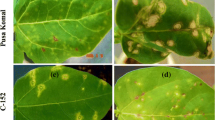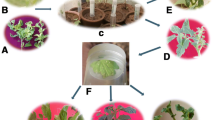Abstract
Gerbera is an important cut flower crop popular throughout the world. In summer months of 2016, gerberas grown in polyhouses of RHREC, GKVK, Bengaluru, Karnataka, India showed heavy infestation of thrips and displayed symptoms of viral infections. Infected plants displayed irregular chlorotic or necrotic spots or blotches, necrosis of veins, bronzing, crinkling and deformations of leaves; necrotic streaks on flower stalks; chlorosis or necrosis of flower petals; tip necrosis or death of young plants. The virus was identified as groundnut bud necrosis virus based on DAC-ELISA, RT-PCR and transmission studies, and it was characterized by cloning and sequencing of N gene and 3′ UTRs. Thrips associated was identified as Scirtothrips dorsalis and the virus was detected in individual thrips using DAC-ELISA. The virus could be efficiently transmitted to cowpea variety C-152 both by mechanical sap inoculation and vector transmission and to tulsi plants by vector transmission. Sequence of S-RNA segment of the virus from two independent gerbera samples was submitted under the accession numbers KX832986.1 and KX832987.1. The two isolates showed per cent identities of 97.1 and 98.5 at N gene and at 3′ UTRs, respectively, with each other and 92.9–99.1% at N gene with other GBNV isolates. Phylogenetically they clustered along with other GBNV isolates reported from different hosts and locations within the major clade of watermelon silver mottle virus serogroup. Differential response was observed in gerbera varieties with respect to incidence of GBNV disease (19.6–80.6%) and thrips (24.6–54.0 thrips/leaf) with the least incidence in the varieties Esmara and Orinaco.




Similar content being viewed by others
References
Adams MJ, Lefkowitz EJ, King AMQ, Harrach B, Harrison RL, Knowles NJ, Kropinski AM, Krupovic M, Kuhn JH, Mushegian AR, Nibert M, Sabanadzovic S, Sanfacon H, Siddell SG, Simmonds P, Varsani A, Zerbini FM, Gorbalenya AE, Davidson AJ (2017) Changes to taxonomy and the International Code of Virus Classification and Nomenclature ratified by the International Committee on Taxonomy of Viruses. Arch Virol 162(8):2505–2538
Amruta BS, LaxmiDevi V, Ramegowda GK, Seetharamu GK, Usharani TR, Krishnareddy M (2020) First report of Groundnut bud necrosis virus infecting anthurium (Anthurium andreanum) in India. New Disease Reports 41:14. https://doi.org/10.5197/j.2044-0588.2020.041.014
Ananthakrishnan TN, Sen S (1980) Taxonomy of Indian Thysanoptera. Zoological Survey of India, Handbook Series, No, p 1
Aswath C, Rao TM (2006) Breeding of gerbera (Gerbera jamesonii Bolus ex. Hooker F.) lines suitable for open field cultivation. J Ornam Hort 9:243–247
Bag S, Rondon IS, Druffel KI, Riley DG, Pappu HR (2014) Seasonal dynamics of thrips (Thrips tabaci) (Thysanoptera:Thripidae) transmitters of Iris yellow spot virus: a serious viral pathogen of onion bulb and seed crops. J Econ Entomol 107(1):75–82
Basavaraj, Mandal B, Gawande SJ, Renukadevi P, Holkar SK, Ravi KS, Jain RK (2017) The occurrence, biology, serology and molecular biology of tospoviruses In: Indian agriculture. In: Mandal B et al (eds) A century of plant virology in India, Springer Nature Singapore Pte Ltd, Singapore.
Bhat AS, LaxmiDevi V, Krishnareddy M (2020) First report of groundnut bud necrosis virus natural occurrence in Solanum nigrum L. in India. J Plant Pathol. https://doi.org/10.1007/s42161-020-00567-6
Boben J, Mehle N, Pirc M, Mavrič Pleško I, Ravnikar M (2007) New molecular diagnostic methods for detection of Chrysanthemum stem necrosis virus (CSNV). Acta Biol Slov 50:41–51
Chatzivassiliou EK, Livieratos I, Jenser G, Katis NI (2000) Ornamental plants and thrips populations associated with tomato spotted wilt virus in Greece. Phytoparasitica 28:257–264
Chen C, Chao CH, Chiu RJ (1996) Studies on host range, transmission and electron microscopy of Peanut chlorotic fan-spot virus in Taiwan. Bull Taichung District Agri Improvement Station Pub 52:59–68
Clark MF, Bar-Joseph M (1984) Enzyme immunosorbent assay in plant virology. In: Maramorsch K, Koprowski H (eds) Methods in virology, pp 51–85, vol II. Academic, New York
Daughtrey MI, Jones RK, Moyer JW, Dau ME, Baker JR (1997) Tospoviruses strike the greenhouse industry:INSV has become a major pathogen on flower crops. Plant Dis 81:1220–1230
Deng Z, Bhattarai K (2018) Gerbera. In: Van Huylenbroeck J (ed) Ornamental crops, handbook of plant breeding, vol 11, Springer International Publishing AG, pp 407–438. https://doi.org/10.1007/978-3-319-90698-0_17
Dickey AM, Kumar V, Hoddle MS, Funderburk JE, Morgan JK, Jara-Cavieres A, Shatters RG, Osborne LS, McKenzie CL (2015) The Scirtothrips dorsalis species complex: endemism and invasion in a global pest. PLoS ONE. https://doi.org/10.1371/journal.pone.0123747
Elliott DR, Lebas BSM, Ochoa-Corona FM, Tang J, Alexander BJR (2009) Investigation of impatiens necrotic spot virus outbreaks in New Zealand. Australas Plant Pathol 38:490–495
Fauquet CM, Mayo MA, Maniloff J, Desselberger U, Ball LA (2005) Virus taxonomy, VIII th Report of ICTV. Academic Press, New York, p 1259
Finlay JR (1975) Cucumber mosaic virus in gerbera. Australas Plant Pathol 4:14
Folmer O, Black M, Hoeh W, Lutz R, Vrijenhoek R (1994) DNA primers for amplification of mitochondrial cytochrome oxidase subunit I from diverse metazoan invertebrates. Mol Mar Biol Biotechnol 3(5):294–299
German TL, Ullman DE, Moyer JW (1992) Tospoviruses: diagnosis, molecular biology, phylogeny and vector relationships. Annu Rev Phytopathol 30:315–348
Gopal K, Krishnareddy M, Reddy DVR, Muniyappa V (2010) Transmission of Peanut yellow spot virus (PYSV) by thrips, Scirtothrips dorsalis Hood. in groundnut. Arch Phytopath Plant Prot 43(5):421–429
Hakkaart FA (1968) A virus disease of Gerbera jamesonii. Eur J Plant Pathol 74:28–29
Hassani-Mehraban A, Dullemans AM, Verhoeven ThJJ, Roenhorst JW, Peters D, van der Vlugt RAA, Kormelink R (2019) Alstroemeria yellow spot virus (AYSV): a new orthotospovirus species within a growing Eurasian clade. Arch Virol 164:117–126
Hemalatha V, Pradnya G, Anjali AK, Krishnareddy M, Savithri HS (2008) Monoclonal antibodies to the recombinant nucleocapsid protein of a Groundnut bud necrosis virus infecting tomato in Karnataka and their use in profiling the epitopes of Indian tospovirus isolates. Curr Sci 95:952–957
Holkar SK, Kumar R, Yogita M, Katiyar A, Jain RK, Mandal B (2016) Diagnostic assays for two closely related tospovirus species, watermelon bud necrosis virus and groundnut bud necrosis virus and identification of new natural hosts. J Plant Biochem Biotechnol. https://doi.org/10.1007/s13562-016-0358-6
ICTV (2018) International Committee on Taxonomy of Viruses Master List 2018b.v2. https://talk.ictvonline.org/files/master-species-lists/. Accessed 20 June 2020
Kazinczi G, Horvath J, Takacs A (2007) Tospoviruses on ornamentals. Plant Viruses 1(2):142–162
Kumar S, Stecher G, Tamura K (2016) MEGA7: molecular evolutionary genetics analysis (MEGA) software version 7.0 for bigger datasets. Mol Biol Evol 33(7):1870–1874
Kunkalikar SR, Sudarsana P, Arun BM, Rajagopalan P, Chen TC, Yeh SD, Naidu RA, Zehr UB, Ravi KS (2011) Importance and genetic diversity of vegetable-infecting tospoviruses in India. Phytopathology 101:367–376
Lakshmi KV, Wightman JA, Reddy DVR, Ranga-Rao GV, Buiel AAM, Reddy DVR (1995) Transmission of Peanut bud necrosis virus by Thrips palmi in India. In: Parker BL, Skinner M, Lewis T (eds) Thrips biology and management. Plenum Press, New York, pp 179–184
Mandal B, Jain RK (2010) ELISA kits for tospoviruses detection. ICAR News, Indian Council of Agricultural Research, New Delhi, p 13
Mandal B, Jain RK, Krishnareddy M, Krishna Kumar NK, Ravi KS, Pappu HR (2012) Emerging problems of Tospoviruses (Bunyaviridae) and their management in the Indian Subcontinent. Plant Dis 96:468–479
Marys E, Mejías A, Rodríguez-Román E, Avilán D, Hurtado T, Fernández A, Zambrano K, Garrido M, Brito M (2014) The first report of Tomato spotted wilt virus on Gerbera and Chrysanthemun in Venezuela. Plant Dis 98(8):1161
Meena RL, Ramasubramanian T, Venkatesan S, Mohankumar S (2005) Molecular characterization of tospovirus transmitting thrips population from India. Am J Biochem Biotech 1:168–173
Moritz G, Paulsen M, Delker C, Picl S, Kumm S (2002) Identification of thrips using ITS-RFLP analysis. In: Marullo R, Mound LA (eds) Thrips and Tospoviruses: proceedings of the 7th international symposium on Thysanoptera, pp 365–367
NHB (2016) National Horticulture Board, Ministry of Agriculture and Farmers Welfare Government of India database. http://nhb.gov.in/. Accessed 18 June 2020
Oliver JE, Whitfield AE (2016) The genus Tospovirus: emerging Bunyaviruses that threaten food security. Annu Rev Virol 3(1):101–124
Pant RP, Basavaraj YB, Srivastava N, Bhattarai A, Kumar A, Baranwal VK, Sailo N, Rampal, Barman D (2019) First Report of Groundnut bud necrosis virus infecting Phaelenopsis in India. 39:17. https://doi.org/10.5197/j.2044-0588.2019.039.017
Pappu HR, Jones RAC, Jain RK (2009) Global status of tospovirus epidemics in diverse cropping systems: Successes achieved and challenges ahead. Virus Res 141:219–236
Reddy DVR, Wightman JA, Beshear RJ, Highland B, Black M, Sreenivasulu M, Dwivedi SL, Demski JW, McDonald D, Smith JW Jr, Smith DH (1991) Bud necrosis: a disease of groundnut caused by Tomato spotted wilt virus, Information Bulletin No. 31. ICRISAT, Patancheru, p 20
Reddy DVR, Ratna AS, Sudarshana MR, Kiran Kumar I (1992) Serological relationships and purification of bud necrosis virus, a tospovirus occurring in peanut (Arachis hypogaea L.) in India. Ann Appl Biol 120:279–286
Riley DG, Joseph SV, Srinivasan R, Diffie S (2011) Thrips vectors of tospoviruses. J Integr Pest Manage 2(1). https://doi.org/10.1603/IPM10020
Rotenberg D, Jacobson AL, Schneweis DJ, Whitfield AE (2015) Thrips transmission of tospoviruses. Curr Opin Virol 15:80–89
Ruth C (2018) Insect transmission of bud necrosis virus infecting tomato (Lycopersicon esculentum Mill.). Int J Agric Sci 10(8):5845–5848
Sambrook J, Fritschi EF, Maniatis T (1989) Molecular cloning: a laboratory manual. Cold Spring Harbor Laboratory Press, New York
Satyanarayana T, Mitchell SE, Reddy DVR, Brown S, Kresovich S, Jarret R, Naidu RA, Damski JW (1996) Peanut bud necrosis tospovirus S RNA: complete nucleotide sequence, genome organization and homology to other tospoviruses. Arch Virol 141:85–98
Singh RB, Srivastava KK, Khurana SMP, Pandey SK (1997) Assessment of yield losses due to potato stem necrosis disease. Indian J Virol 3:135–137
Spanò R, Mascia T, De lucia B, Torchetti EM, Rubino L, Gallitelli D (2011) First report of a resistance breaking strain of Tomato spotted wilt virus from Gerbera jamesonii in Apulia, southern Italy. J Plant Pathol 93(4):63
Turina M, Kormelink R, Resende RO (2016) Resistance to tospovirusus in vegetable crops: epidemiological and molecular aspects. Annu Rev Phytopathol 54:347–371
Umamaheswaran K, Jain RK, Bhat AI, Ahlawat YS (2003) Biological and molecular characterisation of a tospovirus isolates from tomato and its relationship with other tospoviruses. Indian Phytopath 56:168–173
Verma N, Singh AK, Singh K, Raikhy LS, Hallan V, Ram R, Zaidi AA (2004) Occurrence of cucumber mosaic virus in Gerbera jamesonii in India. Plant Dis 88:1161
Whitfield AE, Ullman DE, German TL (2005) Tospovirus-thrips interactions. Annu Rev Phytopathol 43:459–548
Zhang L, Yang C, Yu C, Yuan W, Ma Q (2009) Rapid detection of 3 viruses in Gerbera jamesonii Bolus and its virus-free by tissue culture. Acta Phytophylacica Sin 36:239
Funding
The authors acknowledge the funding from Department of Biotechnology, Government of India, under BioCARe (BT/BioCARe/02/290/2011–12) women scientist programme and University of Horticultural Sciences, Bagalkot under in-house projects (UHS/FLA/S/15–16/1 and UHS/ENT/S/14–15/7).
Author information
Authors and Affiliations
Corresponding author
Ethics declarations
Conflict of interest
The authors declare that there is no conflict of interest in publishing this article.
Additional information
Publisher's Note
Springer Nature remains neutral with regard to jurisdictional claims in published maps and institutional affiliations.
Rights and permissions
About this article
Cite this article
Bhat, A.S., Laxmidevi, V., Ramegowda, G.K. et al. Molecular identification and characterization of groundnut bud necrosis virus and its associated thrips vector from Gerbera jamesonii in India. J Plant Dis Prot 128, 673–683 (2021). https://doi.org/10.1007/s41348-021-00425-2
Received:
Accepted:
Published:
Issue Date:
DOI: https://doi.org/10.1007/s41348-021-00425-2




